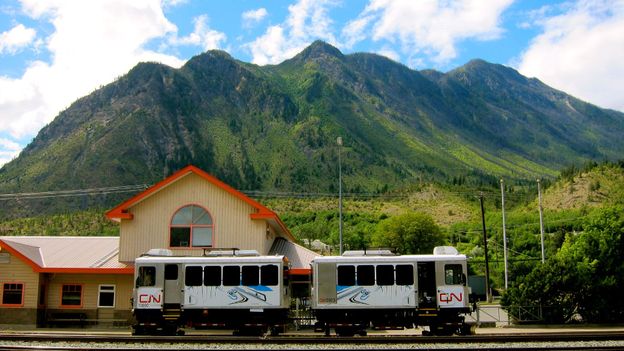kEiThZ
Superstar
Is there any reason VIA can't just order more carriages and add capacity? How much would it cost to do?
They likely could, however it would delay the full rollout of the equipment.Is there any reason VIA can't just order more carriages and add capacity? How much would it cost to do?
Possibly - if the government was willing to write the cheque. Given Siemen's likely order book, if an approved fix (scrubber, shunt 'enhancer', etc.) was in the foreseeable future, it might be faster to simply wait it out.Is there any reason VIA can't just order more carriages and add capacity? How much would it cost to do?
Siemens is opening an additional factory for Venture coaches in Lexington North Carolina in a few months so they will be catching up their backlog pretty soon.Possibly - if the government was willing to write the cheque. Given Siemen's likely order book, if an approved fix (scrubber, shunt 'enhancer', etc.) was in the foreseeable future, it might be faster to simply wait it out.
Siemens will also have the challenge of ensuring standing up a new line in SC doesn’t compromise build quality. Boeing did not pull that off, to put it mildly.Siemens is opening an additional factory for Venture coaches in Lexington North Carolina in a few months so they will be catching up their backlog pretty soon.
Via probably does need to order a few more Economy class coaches to lengthen some trains from 2+3 (business + economy) to 2+4. Reallocating Economy coaches from the existing 5-car sets wouldn't work since that would produce 2+2 sets which wouldn't make sense.

rich coming from a company whos experienced numerous derailments with their trains annually..."CN said it advised Via in October 2021 that operating trainsets with an axle count of 24 rather than 32 "could create issues." It said it imposed the rule requiring either a higher axle threshold or lower speeds in March on routes where the new fleet was running.
"This is a safety issue, both for the trains and their passengers, but also for pedestrians and motorists at crossings. Safety is not something we can compromise on, ever," said CN spokesman Jonathan Abecassis in an emailed statement."
Let’s not forget about the red signals they hit, one of them almost causing a deadly collision with a VIA train, as reported in a TSB report this week which got conveniently drowned in CN making noise about how serious they are about safety, while fighting the any mandate to install any technology which could prevent such accidents:rich coming from a company whos experienced numerous derailments with their trains annually...
Let’s not forget about the red signals they hit, one of them almost causing a deadly collision with a VIA train, as reported in a TSB report this week which got conveniently drowned in CN making noise about how serious they are about safety, while fighting the any mandate to install any technology which could prevent such accidents:
On April 13, 2023, the CN train was travelling east on the south track of the Kingston Subdivision when it passed a Clear to Stop signal which indicates to proceed and prepare to stop at the next signal. The CN crew missed the signal, and as the train approached the Stop signal at Wesco, near Cornwall, they applied the train air brakes in emergency and made an emergency radio broadcast.
At the same time, the VIA passenger train was approaching Wesco on the same track, where it was lined to cross over to the north track. Upon hearing the emergency radio broadcast from the CN crew, the VIA train crew brought the passenger train to a controlled stop, coming to rest about 1100 feet from the CN train.
The investigation determined that the CN train crew was focused on preparing for future tasks which divided their attention from the primary task of following railway signal indications, resulting in the missed Clear to Stop indication. As a result, the crew was not prepared to stop at the next signal so when the emergency braking was applied, there was an insufficient distance to stop the train before passing the signal.
Risk of collision between two trains in Ontario highlights the need for physical safety defences on Canada’s railways - Transportation Safety Board of Canada
Today, the Transportation Safety Board of Canada (TSB) released its investigation report (R23H0006) into an incident where a Canadian National Railway Company (CN) freight train nearly collided head-on with a VIA Rail Canada Inc. (VIA) passenger train carrying 167 passengers near Cornwall, Ontario.www.tsb.gc.ca
If CN's equipment can't reliably detect trains with 24 axles, that's pretty sad. Globally it's common to have trains with as few as 6 axles, and sometimes even 4.
Passenger trips to take longer in Ontario and Quebec after CN rule change: Via Rail
Passengers riding on Via Rail’s most heavily travelled corridor may endure a slower trip after Canadian National Railway Co. imposed restrictions on Via’s new trains.www.cp24.com
"CN said it advised Via in October 2021 that operating trainsets with an axle count of 24 rather than 32 "could create issues." It said it imposed the rule requiring either a higher axle threshold or lower speeds in March on routes where the new fleet was running.
"This is a safety issue, both for the trains and their passengers, but also for pedestrians and motorists at crossings. Safety is not something we can compromise on, ever," said CN spokesman Jonathan Abecassis in an emailed statement."
Thank you for pointing out that a massive proportion of train movements worldwide have less than 32 axles! If it can’t reliably detect a train, then the problem is with your train detection equipment, not the train…If CN's equipment can't reliably detect trains with 24 axles, that's pretty sad. Globally it's common to have trains with as few as 6 axles, and sometimes even 4.
If they say they need 32 axles (a loco + 7 coaches) that's a pretty damning indictment of their own detection equipment, even if the wheels/axles of venture coaches are harder to detect

To be fair, from Google sat images, it doesn't look like it encounters any signalized crossing (or hardly any crossings at all for that matter). From what I have read, the shuttle operates at a fairly sedate speed and the line is decidedly low tech.Let’s also not forget this extremely leightweight 4 axle train working one of their main lines in BC:
The point remains that if they procure equipment which is unsuitable for the kind of train movements they will foreseeably have to handle, then the problem are CN’s procurement practices, not those of VIA…To be fair, from Google sat images, it doesn't look like it encounters any signalized crossing (or hardly any crossings at all for that matter). From what I have read, the shuttle operates at a fairly sedate speed and the line is decidedly low tech.




